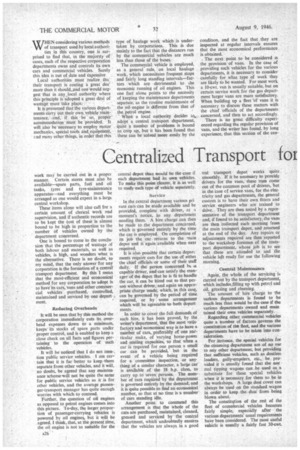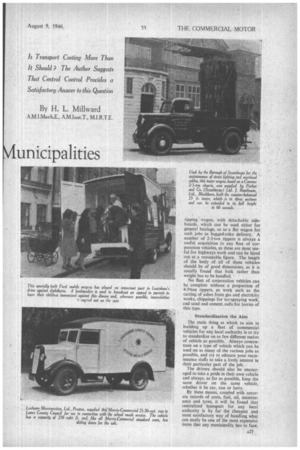Centralized Transport for unicipalities
Page 28

Page 29

If you've noticed an error in this article please click here to report it so we can fix it.
Is Transport Costing More Than It Should ? The Author Suggests That Central Control Provides a Satisfactory Answer to this Question
By H. L. Millward
A.M.1.Mech.E., A.M.Inst.T., M.I.R.T.E. WHEN considering various methods of transport used by local authorities in this country, one is surprised to find that, in the majority of cases, each of the respective corporation departments owns and controls its own cars and commercial vehicles. Surely this idea is out of date and expensive
Local authorities must realize tha• their transport is costing a great dea' more than it should„and one would suggest that in any local authority where this principle is adopted a great deal of wastage must take place.
It is presumed that the various departments carry out their own vehicle maintenance, and, if this be so, proper accommodation must be provided. It will also he necessary to employ motor mechanics, special tools and equipment, end many other things, in order that this work may be carried Out in a proper manner. Certain stores must also be available—spare parts, fuel and oil tanks, tyres and tyre-maintenance apparatus—and everything must be arranged as one would expect in a large central workshop.
These items alone will also calf for a certain amount of clerical work and supervision, and if authentic records are to be kept the cost of these is almost bound to be high in proportion to the numbet of vehicles owned by the department concerned.
One is bound to come to the conclusion that the percentage of wastage ,st both labour and materials, as well as vehicles, is high, and wonders what is the alternative. There is no doubt, to my mind, that the only answer for any corporation is the formation of a central transport department. By this I mean that the most-efficient and economical method for any corporation to adopt is to have its cars, vans and other commercial vehicles purchased, controlled, maintained and serviced by one depart merit.
Reducing Overheads
It will be seen that by this method the corporation immediately cuts its overhead expenses down to a minimum, keepsits stocks of spare parts under proper control, and is enabled to keep a close check on all facts and figures pertaining to the operation of such vehicles.
It will be noticed that I do not mention public service vehicles. I am certain that it is far better to keep them separate from other vehicles, and it will, no doubt, be agreed that any maintenance scheme 'will not be quite the same for public service vehicles as it is for other vehicles, and the average passenger-transport manager has quite enough worries with which to contend.
Further, the question of oil engines as opposed to petrol engines comes into this picture. To-day, the larger proportion of passenger-carrying vehicles is powered by oil engines, but it will be agreed,1 think, that, at the present titne, the oil engine is not as sortable for the • type of haulage work which is undertaken by corporations. This •is due mainly to the fact that the distances run by the commercial vehicles are much less than those of the buses.
The commercial vehicle is employed, as a general rule, on local haulage work, which necessitates frequent stops and fairly long standing intervals—factors which are • detrimental to the economic running of oil engines. This one fact alone points to the necessity of keeping the maintenance departments separate, as the routine maintenarke of the oil engine is different from that of the, petrol engine.
When a local authority decides to., adopt a central transport department, quite a number of problems is bound to crop up, but it has been found that these can be solved more easily, by the
central depot than would be the case if each department had its own o:hides. To make this point dealer, it is as well to study each type of vehicle separately.
Service In the central department various pri vate cars can be made available and be provided. complete with driver, at a moment's notice, to any department needing them. A hire charge can then be made to the department conc.erned, which is governed entirely by the time the car is employed. On completion of its job the car returns to the main depot and is again available when next required.
It is also possible that certain depart meats require cars for the use of either the chief officials or some of their staff daily. If the person concerned be in capable driver, and can satisfy the manager of the depot that he is fit to handle the car, it can be hired out to that person without driver, and again an appropriate charge made, which, in this case, can be governed by the period of time required, or by some arrangement which will be agreeable to both depart ments.
In order to cover the full demands of such hire, it has been proved, by the writer's department, that The most satisfactory and economical way is to have a number of cars, preferably of one oarticular make, of varying horse-powei and seating capacities, so that when a car is required for one person a small car can be provided. but in the event of a vehicle being required for a committee inspection, or anything of a similar character, a large car is available of the 18h.p. class, to carry up to seven persons. The number of cars required by the department is governed entirely by the demand, and it is quite possible to find an economical number, so that at no time is a number of cars standing idle.
Another point to commend this arrangement is that the whole of the cars are purchased; maintained, cleaned, greased and serviced by the central department, whkti undoubtedly ensures that the vehicles are always in a good condition, and the fact that they are inspected at regular intervals ensures that the most economical performance is obtained.
. The next point to be considered is the provision of vans. In the case of providing such vehicles for the various departments, it is necessary to consider carefully for what type of work they are likely to be wanted. For most work a 10-cwt. van is usually suitable, but on certain service work for the gas department larger vans are more satisfactory. When building up a fleet bf vans it is necessary to discuss these matters with the chief officials of the departments concerned, and then to act accordingly.
There is no great difficulty experienced regarding the regular provision of vans, and the writer has found, by long experience, that this section of the cen teal transport depot works quite smoothly. If it be necessary to provide drivers for the vans, these men come out of the common pool of drivers, but in the case cf sertrice vans, for the electricity and gas departments, the general custom is to have their own fitters and service engineers who are trained to drive. They are then tested by a representative of the transport department and, if found to be satisfactory, the vans are then tkillected each morning from the main transport depot, and returned at the end of the day, Any repairs or adjustments required are then reported to the workshop foreman of the transport department, whose job is to see that these are attended to and the vehicle left ready for use the fallowing morning. ..
Central Maintenance
Again, the whole of the servicing is carried out by the transport department, which inclades.filling up with petrel and oil, greasing and cleaning.
The amount of hire charge to the various departments is found to be much less than would be the case if the various departments owned and main tabled their own vehicles separately, Regarding other commercial vehicles quite a number of factors governs the constitution of the fleet, and the various departments have to be taken into consideration, For instance, the special vehicles for the cleansing department are of no use to any other department, but providing that sufficient vehicles, such as dustless loaders, gully-ernptiers, etc., be pro vided it is usually found that the nor mal tipping wagons can be used as a substitute for these -special vehicles when it is necessaryfor them to be iv the workshops. A large dust cover can always be used on the standard wagon in order to keep the. dust from being blown about.
The constitution of the rest of the fleet of commercial vehicles becomes fairly simple, especially after the various departments' usual requirements have been considered. The most useful vehicle is usually a fairly fast 30-cwt.
tipping wagon, with detachable sideboards, which can be used either for general haulage, or as a flat wagon for such jobs as bagged-coke delivery. A number of 2-3-ton tippers is always a useful acquisition to any fleet of corporation vehicles, as these are most useful for highways work and can be hired out at a reasonable figure. The length of the body of all of these vehicles should be of good dimensions, as it is usually found that bulk rather than weight has to be handled.
No fleet of corporation vehicles can be complete without a proportion of 4-5,ton tippers, as work such as the carting of ashes from gas and electricity works, chippings for tar-spraying work, and sand and cement, calls for lorries of this type.
Standardization the Aim The main thing at which to aim in building up a fleet of commercial vehicles for any local authority is to try to standardize on as few different makes of vehicle as possible. Always concentrate on a type of vehicle which can be used on as many of the various jobs as possible, and try to educate your maintenance staffs to take a lively interest in their particular part of the job.
The drivers should also be encouraged to take a pride in their own vehicle and always, as far as possible, keep the same driver on the same vehicle, whether it be car, van or lorry.
By these means, coupled with accurate records of costs, fuel, oil, maintenance and tyres, it will be found that centralized transport for any local authority is by far the cheapest and most satisfactory way of handling what can easily be one of the most expensive items that any municipality has to face.




































































